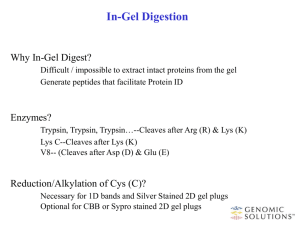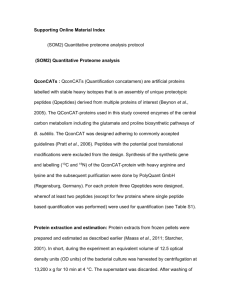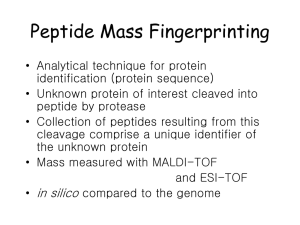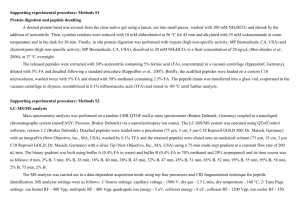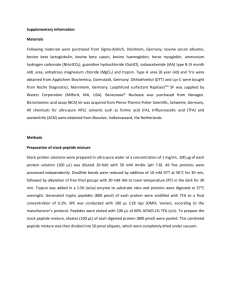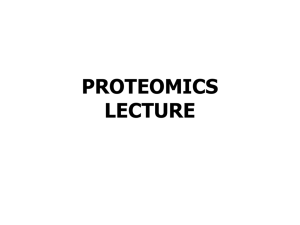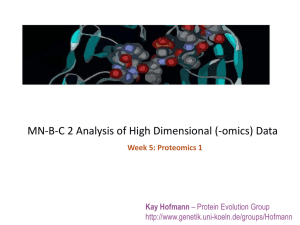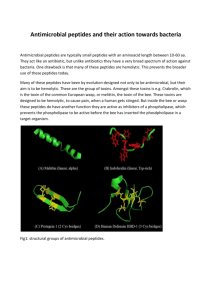bio98a_l05
advertisement
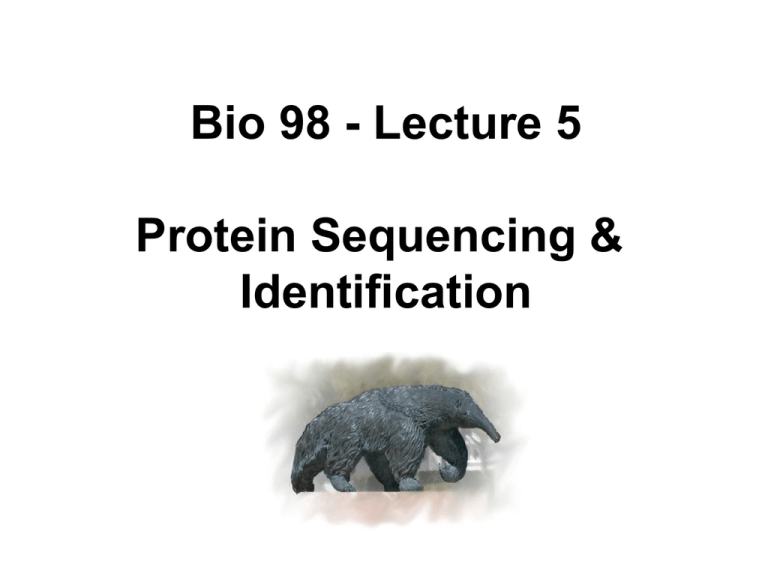
Bio 98 - Lecture 5 Protein Sequencing & Identification Protein Identification I. Why? • Find proteins associated with cancer and other disease states • Study protein modifications and interactions II. Typical approach 1. 2D gel electrophoresis - very high resolution separation of complex protein mixtures 2. Digest protein of interest with protease 3. Determine sequences or masses of the resulting peptides 4. Deduce sequence or match masses to parent protein Proteins in a bacterial proteome 2D gel pH 3 isoelectric point pH 12 200 kDa molecular weight 10 kDa Proteins: E. coli: ~4,000; H. sapiens: ~20,000 2D gel electrophoresis Proteins in a bacterial proteome 2D gel pH 3 isoelectric point pH 12 200 kDa molecular weight 10 kDa Proteins: E. coli: ~4,000; H. sapiens: ~20,000 Sequencing Proteins: A Stepwise Overview I. II. III. IV. V. Break and then block disulfide bonds. Cleave protein into smaller peptides. Separate the peptides. Sequence the peptides. Align the peptide sequences. Insulin processing insulin I. Breaking and blocking disulfide bonds oxidation reduction Most common method: reduction & alkylation (next slides) (i) Reduction step BME --Cys-| S | S | --Cys-- 2 R-SH 2(beta)-mercaptoethanol or dithiothreitol (DTT) --Cys— | SH + SH | --Cys-- R | S | S | R (ii) Blocking step - alkylation = O --Cys-| SH + I-CH2-C-Oiodoacetic acid = --Cys-O | S-CH2-C-Ocarboxylmethylcysteine (CMC) + HI II. Cleavage - using enzymes or chemicals Enzymatic cleavage into peptide fragments using protease enzymes O O ---NH-CH-C-NH-CH-C--R1 R2 Protease X + H2O O ---NH-CH-C-O + R1 O NH3-CH-C--R2 + B. Reagents for selective cleavage of peptide bonds Protease (source) Specificity (N/C) Trypsin (bovine pancrease) Chymotrypsin (bovine pancrease) Staphylococcus V8 protease Pepsin (porcine pancrease) Cyanogen bromide (chemical) Lys, Arg (C) Phe, Trp, Tyr (C) Glu, Asp (C) Phe, Trp, Tyr (N) Met (C) Peptide cleaved by Trypsin N-terminus Met-Leu-Trp-Ala-Cys-Lys-Ala-Gly C-terminus Peptide cleaved by Pepsin N-terminus Met-Leu-Trp-Ala-Cys-Lys-Ala-Gly C-terminus III. Separation & purification of peptides HPLC: high-performance liquid chromatography 1. A form of liquid chromatography (LC) with small column size, small “beads” inside column and high pressure. 2. Typically uses “reversed-phase” columns for separating peptides. • analogous to ion-exchange, except binding of protein to bead is via hydrophobic interaction, not charge. • elute peptides from “reversed-phase” beads by increasing organic solvent, typically methanol or acetonitrile, instead of salt. hydrophobicity of peptides % acetonitrile (------) absorbance at 214 nm ( _____ ) Peptide separation by HPLC Elution time (mins) IVa. Sequencing a polypeptide via Edman degradation Phenyl-iso-thio-cyanate N=C=S PITC + polypeptide N • PTH-AA1 Phenylthio-hydantoin derivative N • C shortened polypeptide C • repeat the cycle identification by HPLC IVa2. Scheme of Edman degradation IVa3. Complications with Edman degradation: Blocked N-terminus fMet-Ala-Ser-Glu-… V. Aligning the peptides to establish final sequence Trypsin cuts C-term of Lys (K), Arg (R) Cyanogen bromide cuts C-term of Met (M) IVb. Sequencing a polypeptide via mass spectrometry (MS) Spectral Output Tandem MS or MS/MS 2D gel electrophoresis 2D gel electrophoresis Peptide Mass Fingerprinting (PMF) 1. Cut out the gel spot containing your protein of interest and digest it with a protease such as trypsin. 2. Then submit the entire mixture of peptides to mass spectrometry. Tell computer 1. cleavage agent used 2. list of peptide masses Get from computer List of proteins that could have produced those peptides

